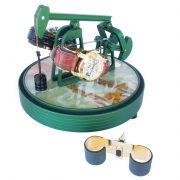What is a Watch Winder?
A watch winder is a device that rotates automatic (also known as self-winding) watches to ensure their power reserve doesn’t deplete. But first, before we go any further, a little bit of history about automatic watches…
The history (and science) of automatic watches
Automatic watches date back to 1776 when Abram Louys Perrelet, the church elder, made the first practical self-winding watch in Le Locle, Swizterland. (If you want to find out more about the history of automatic watch winders, here’s a great document.) Incredibly, the essence of how these marvelous timing machines work hasn’t changed at all in the past few centuries. Basically, a weight underneath the crown rotates with the wearer’s movements. This weight is connected to a rotary spring that only allows it to rotate in one direction from its input and in the opposite direction of its output. The output of the spring feeds into the watch mechanism, which transforms a constant force into a discrete stepping movement.
How does a watch winder work?
Now that we know how automatic watches work, it’s easier to understand how watch winders work. Watch winders vary greatly in forms, capacity, style, and price, but they also have many common elements. Despite their differences, a watch winder will have at least one holder where the watch can be attached. By construction, and almost without exception, automatic watches need to be wound by rotating them around the normal axis of the crown when the watch axis is perpendicular to the force of gravity. So, translated into normal English… the position of the watch holder is always perpendicular to the ground. This perpendicular rotation also minimizes internal friction in the watch.
Watch winders offer several modes of rotation, which include speed, direction, and idle time. All three of them are important. Speed has a direct and quadratic correlation with internal mechanical watch stress — too little and the watch will lose energy faster than it’s harvested; too fast and overwinding and weakening of the mechanism will probably occur. Direction is important because some automatic watches only collect energy in one rotation direction. Finally, idle times are important to avoid overwinding and mechanical stress.
Watch winders are most commonly fed by electricity through a cable and an AC/DC transformer. Magnetic energy transmission (like those cool new induction pads you may have seen for charging phones) is not a possibility since the variable magnetic field would likely disturb, if not completely break, the watch mechanics. Some watch winders offer batteries, but that increases the weight of the watch winder and also requires periodic recharging.
Why are watch winders important?
Watch winders are gaining importance in the horologe industry. Today there are thousands of people with personal collections of at least two automatic watches. Watch winders help the public in at least three ways: Firstly, they ensure their watches are wound and ready to be worn at all times. Secondly, if not worn regularly, watches will suffer; the tiny amounts of lubricant in critical components of the watch tend to solidify, preventing a proper lubrication that would harm the mechanism. Lastly, watch winders have become a compliment to any watch collection as a way to show them off. Whether it’s in an office, a bedroom, or a living room, a watch winder is the perfect way to showcase your time pieces.
Can all watches be wound with a watch winder?
Only automatic watches can be wound with a watch winder. As long as your watch is an automatic one though, the brand doesn’t matter. Your watch could be a Rolex, Omega, Panerai, Ulysses Nardin, Seven Friday or an Hublot, to name a few.
Do I need a watch winder?
If you are a watch aficionado, you will most likely benefit from having a watch winder. If used properly, a watch winder will probably pay for itself by saving you money in costly repairs. Not only that, it will also give you the ability to switch watches in a heart beat, removing all the necessary hour and date setting along with manual winding.
Watch winders are also great conversation starters. Place a couple of your time pieces on a watch winder in your living room or office desk and you will surely draw attention and curiosity towards your collection… including your winder ;).



